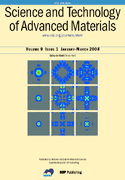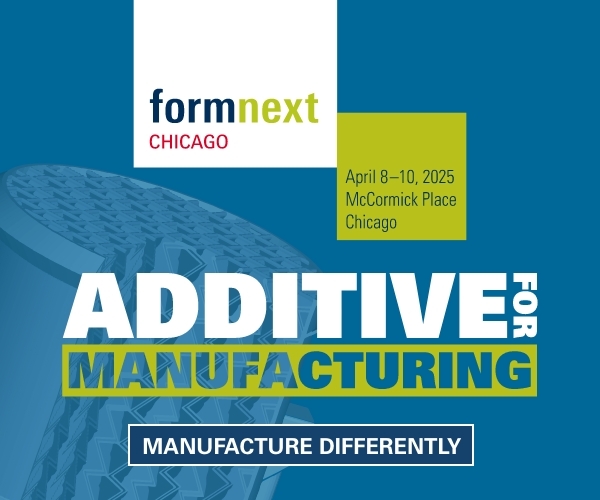After Generating Intense Social Media Interest, 3D Printing Chemistry Article Wins the STAM 2016 Altmetric Award
 Back in early 2016, a team of researchers from American University discovered an innovative way to combine chemistry and 3D printing: the researchers, led by university chemistry professor Matthew Hartings, figured out how to create structures using active chemistry, while 3D printing commercially. The team published their findings in the journal Science and Technology of Advanced Materials, or STAM, in the paper ‘The chemical, mechanical, and physical properties of 3D printed materials composed of TiO2-ABS nanocomposites,’ authored by Abigail E. Miller, Jake M. Esenther, Matthew R. Hartings, Matthew R. Skorski, and Zeeshan Ahmed. There was so much social media interest in the article on chemically active 3D prints that the team has been awarded STAM’s 2016 Altmetric Award.
Back in early 2016, a team of researchers from American University discovered an innovative way to combine chemistry and 3D printing: the researchers, led by university chemistry professor Matthew Hartings, figured out how to create structures using active chemistry, while 3D printing commercially. The team published their findings in the journal Science and Technology of Advanced Materials, or STAM, in the paper ‘The chemical, mechanical, and physical properties of 3D printed materials composed of TiO2-ABS nanocomposites,’ authored by Abigail E. Miller, Jake M. Esenther, Matthew R. Hartings, Matthew R. Skorski, and Zeeshan Ahmed. There was so much social media interest in the article on chemically active 3D prints that the team has been awarded STAM’s 2016 Altmetric Award.
 The “intense interest,” in both mainstream and social media, in the team’s results, which demonstrate the chemical reactivity of nanocomposites in 3D printed structures, led them to win the award. Hartings said that winning this award was very satisfying, because it shows that their research had moved beyond the academic world to attract interest from people who are not specialists in the chemistry field. He has a theory as to why this occurred.
The “intense interest,” in both mainstream and social media, in the team’s results, which demonstrate the chemical reactivity of nanocomposites in 3D printed structures, led them to win the award. Hartings said that winning this award was very satisfying, because it shows that their research had moved beyond the academic world to attract interest from people who are not specialists in the chemistry field. He has a theory as to why this occurred.
Hartings said, “People (secretly, sometimes) love having control. They love to be able to design and create and build. 3D printing facilitates this kind of creative control. With the technologies that we are developing, we are adding a 4th dimension to 3D printing: chemistry.”
![3D printed polymer structures containing TiO2 nanoparticles at 0, 1 and 5% by dry weight (L to R). Chemical activity of the TiO2 nanoparticles suppresses the fluorescence of the host poly polymer. [Image: PR Web]](https://3dprint.com/wp-content/uploads/2017/01/3D-printed-polymer-structures-featured.png)
3D printed polymer structures containing TiO2 nanoparticles at 0, 1 and 5% by dry weight (L to R). Chemical activity of the TiO2 nanoparticles suppresses the fluorescence of the host poly polymer. [Image via PR Web]
“I’m really interested in the way that our 3D printed nanocomposites can store and filter gases. Developing new ways to trap gases like carbon dioxide and hydrogen and methane will have huge implications for our environment and society,” said Hartings.
In a nutshell, researchers doused a small, plastic structure with chemically active titanium dioxide (TiO2) nanoparticles, then added them to a standard 3D printing filament and printed a small, plastic matrix. TiO2 is a semiconductor, and in the form of nanoparticles, due to its increased surface area, it features enhanced photocatalytic properties. The experiment, with a resounding ‘yes,’ answered two key questions:
- Would the nanoparticles stay active in the structure once printed?
- Created for pollution mitigation, would the matrix perform?
In chemistry experiments, the technology has historically been used only to produce structures used to help research other materials and structures, like reactionware, instead of creating structures to be studied.
Hartings said, “As a chemist, printed things are kind of boring. I wanted 3D printed objects to be able to do chemistry after they were printed.”
Until now, chemists really only thought of 3D printed structures as inert objects. But thanks to the efforts of Hartings and his now award-winning team and experiment, it looks like that could change. Discuss in the American University forum at 3DPB.com.
Subscribe to Our Email Newsletter
Stay up-to-date on all the latest news from the 3D printing industry and receive information and offers from third party vendors.
You May Also Like
Creality Begins Selling HALOT-MAGE S: Setting New Standards in Precision 3D Printing
Creality, a leading innovator in consumer-grade 3D printing technology, proudly introduces the HALOT-MAGE S, the latest breakthrough in high-resolution 3D printing. With its cutting-edge features and user-centric design, the HALOT-MAGE...
Farsoon Showcases Comprehensive 3D Printing Solutions, Automation, and More at TCT Asia
This year’s TCT Asia event showcased just how much the Asian additive manufacturing (AM) market has grown, with Eplus3D’s 64-laser metal 3D printer alone acting as a synecdoche for China’s...
Creality Launches Ender-3 V3 Plus: Bigger CoreXZ for Unprecedented Performance
Embracing a journey of innovation and excellence, Creality’s Ender-3 series has established a distinguished path in the field of 3D printing. From the entry-level Ender-3 V3 SE to the feature-rich...
Laser Wars: Eplus3D Unveils Metal 3D Printer with up to 64 Lasers
Now that the laser wars in the powder bed fusion (PBF) space have, for the most part, moved to China, original equipment manufacturers (OEMs) there are in fierce competition. Eplus3D...

































